Common menu bar links
Breadcrumb Trail
ARCHIVED - Public Safety and Emergency Preparedness Canada
 This page has been archived.
This page has been archived.
Archived Content
Information identified as archived on the Web is for reference, research or recordkeeping purposes. It has not been altered or updated after the date of archiving. Web pages that are archived on the Web are not subject to the Government of Canada Web Standards. As per the Communications Policy of the Government of Canada, you can request alternate formats on the "Contact Us" page.
Minister's Message
 I
am pleased to present Public Safety Canada's Report on Plans and Priorities for 2010-11. It lays out the priorities that
the Department will advance over the coming year to help build a safe and resilient Canada.
I
am pleased to present Public Safety Canada's Report on Plans and Priorities for 2010-11. It lays out the priorities that
the Department will advance over the coming year to help build a safe and resilient Canada.
There is no more fundamental role for the federal government than helping to keep Canadians safe and secure. This is a monumental task, given the real and evolving threats faced by Canada. The recent attempted bombing of Northwest Airlines flight 253, reminds us all of how real these threats are and how they have the potential to do harm to our fundamental way of life.
Public Safety Canada plays a key role in helping keep Canadians safe and secure by working to protect Canada's national security, making sure that we are prepared to deal with a major incident, and that we have an effective approach to federal law enforcement, corrections, crime prevention and managing our nation's borders. This role is carried out in close collaboration with Public Safety Portfolio partners, other government departments, Provinces and Territories, international allies, first responders, the private sector and individual Canadians.
Last fiscal year, the Department had a number of accomplishments. It supported Health Canada by ensuring that the federal government was able to continue delivering critical services during the H1N1 epidemic; developed legislative options to enhance the Corrections and Conditional Release Act, the Sex Offender Information Registration Act, the Technical Assistance for Law Enforcement in the 21st Century Act (Lawful Access) and the Justice for Victims of Terrorism Act. We also improved dialogue with our counterparts at the U.S. Department of Homeland Security; finalized an agreement with the U.S. to govern joint cross-border law enforcement operations (known as Shiprider); participated in the federal government's security preparations for the Olympics and Paralympic Winter Games; was instrumental to the federal response to the earthquake in Haiti; and contributed to the investigation that led to the successful prosecution of several members of the “Toronto 18” terrorist group, amongst others.
Over the coming year, the Department will continue to focus on priorities in the areas of national security, emergency management response, effective law enforcement, and border security. In addition, Public Safety Canada will continue to support Canada's whole-of-government engagement in Afghanistan and other locations such as Haiti, and in providing strategic advice and support in safety and security matters related to the G8, G20 and the North American Leaders' Summits.
The Honourable Vic Toews, P.C., Q.C., M.P.
Minister of Public Safety
Section I: Departmental Overview
Public Safety Portfolio
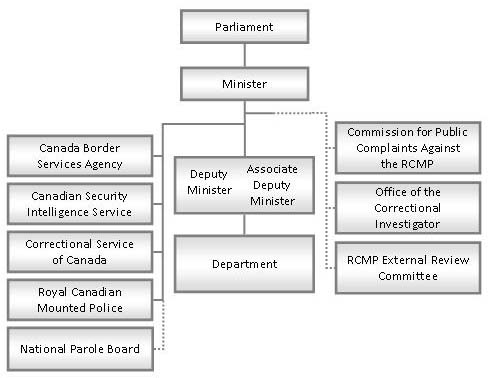
The Public Safety Portfolio is large and complex. It encompasses nine distinct organizations all of which directly contribute to the safety and security of Canadians. In addition to Public Safety Canada, the Portfolio includes the Canada Border Services Agency (CBSA), the Canadian Security Intelligence Service (CSIS), the Correctional Service of Canada (CSC), the National Parole Board (NPB), and the Royal Canadian Mounted Police (RCMP). It also includes three arms-length review bodies: the RCMP External Review Committee, the Commission for Public Complaints Against the RCMP, and the Office of the Correctional Investigator.
Public Safety Canada's Responsibilities
Public Safety Canada plays a key role in developing policies, delivering programs and ensuring cohesion and integration on policy and program issues within the Portfolio. The Department works with other federal departments, other levels of government, first responders, community groups, the private sector and other countries to achieve its objectives. Through the development and implementation of clearly articulated policies and programs, the Department works towards the achievement of its strategic outcome: A safe and resilient Canada.
The Department provides strategic policy advice and support to the Minister of Public Safety on a range of issues, including: national security; emergency management; law enforcement; border management; corrections; and crime prevention.
Approximately 65 percent of the Department's budget is devoted to delivering grant and contribution programs related to emergency preparedness and response, and community safety.
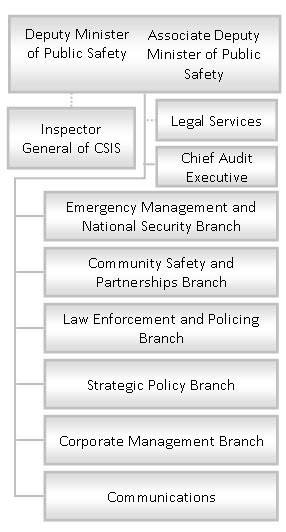
Public Safety Canada is structurally organised into five branches: Emergency Management and National Security, Community Safety and Partnerships, Law Enforcement and Policing, Strategic Policy and Corporate Management. The Branches are supported by the Communications Directorate and the Legal Services Unit. The Department has a Chief Audit Executive. Also situated within the Department is the Office of the Inspector General of CSIS, which carries out independent reviews of CSIS' compliance with the law, ministerial direction and operational policy.
Strategic Outcome and Program Activity Architecture
The chart below illustrates Public Safety Canada's strategic outcome and its Program Activity Architecture (PAA).
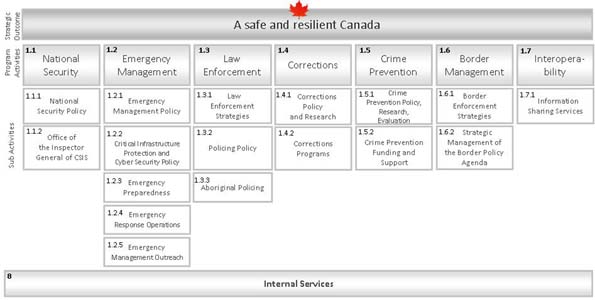
The Department is currently reviewing its PAA and will be proposing a streamlined architecture to better reflect the Department's work and facilitate departmental reporting requirements. Additionally, the Department's ongoing development of its Performance Measurement Framework (PMF) will help inform decisions on program relevance, effectiveness and value for money; support the realignment of spending; identify horizontal linkages among programs; and provide better information to Parliamentarians and Canadians on spending and results.
The performance indicators currently found in this report remain preliminary. Some lack specific targets due to the absence of baseline data. Strengthening the Department's PMF remains a priority.
Operating Environment and Risk Analysis
The work of Public Safety Canada is carried out in an environment that is complex and constantly changing. By its very nature, this work involves the continuous assessment of threats and risks, which can be transnational, national or local in scope, immediate and/or longer term.
Public Safety Canada plays a role in helping to mitigate risks to Canada's safety and security by preventing, to the extent possible, threats from materializing. In this context, over the planning period, the Department will continue to improve its understanding of the national security threats it faces, and will identify ways to improve how these threats will be addressed. It will also continue to work with federal and other partners to help ensure that adequate security measures are put in place for the G8, G20 and North American Leaders' Summits and that the Government is prepared should an incident occur. The Department will continue to play a role in whole-of-government efforts in Afghanistan to help ensure that it does not again become a safe haven for terrorists who wish to do us harm.
Public Safety Canada will work to help protect the country from threats that cannot be prevented. There is no risk-free environment. The country is not immune to organized crime which often transcends Canada's borders, or crime happening locally in a community. The Department will continue its work on crime prevention by pursuing targeted interventions that address known risk factors in an effort to provide alternatives to a life of crime. Public Safety Canada will also work to help ensure that Canada's corrections system is efficient and effective and that it recognizes the needs of victims, while supporting the rehabilitation of offenders. Finally, work will continue on ensuring that Canada's national police force has the tools, policies, programs and accountability structures in place to effectively protect Canadians and maintain their trust.
Public Safety Canada must be prepared to respond effectively in the event that an incident happens. The Department will continue to implement strategies and action plans that will help mitigate the impact of any incident. This includes the implementation of Canada's National Strategy and Action Plan for Critical Infrastructure, the Federal Emergency Response Plan and other initiatives such as tackling cyber-enabled threats – the fastest growing challenge to Canadians and its economy – and the Cross Border Protocol on the Movement of Goods and People across the Canada-U.S. Border during and following an incident.
In carrying out its mandate, Public Safety Canada will continue to work with its federal partners, other levels of government, non-governmental organizations, the private sector and international allies. With respect to the latter, the U.S. Department of Homeland Security remains Public Safety Canada's key bilateral partner given our proximity, interrelated economies and shared borders. Managing risks will continue to require effective Canada-U.S. engagement.
Priorities Summary
In pursuit of the strategic outcome of a safe and resilient Canada, Public Safety Canada will direct its efforts towards four priorities in 2010-11.
| Contribution of Priority to Strategic Outcome: Public Safety Canada develops national policies, response systems and standards to reduce the impact of emergencies that could affect Canada's population and infrastructure. These efforts include national leadership; enhancing the Government of Canada's readiness to respond to all types of emergencies; and improving information sharing and collaboration with other levels of government, as well as the private sector. During the 2010-11 fiscal year, the Department will focus on its federal leadership role and respond to the recommendations contained in the Auditor General's November 3, 2009 Report. Additionally, the Department will pay particular attention to enhancing Canada's national security framework by advancing legislative proposals, policies and programs which comprise the national security framework in an effort to protect Canadians and help ensure that this country is not a base for threats against others. |
|
To measure success in achieving this priority, the Department will use the following indicators:
|
|
To achieve this priority, the Department will support a number of initiatives including
the following:
|
|
| Type: New | PAA link: National Security, Emergency Management |
| Contribution of Priority to Strategic Outcome: In keeping with Public Safety Canada's mandate of exercising national leadership and coordination, the Department will continue to collaborate with various federal departments and agencies on horizontal issues in 2010-11 to provide strategic policy advice and support for established government-wide priorities. Examples of these efforts include Government of Canada efforts in Afghanistan, security for the G8, G20 and North American Leaders' Summits and the provision of counter-terrorism and law and order capacity building abroad. |
|
To measure success in achieving this priority, the Department will use the following indicators:
|
|
To achieve this priority, the Department will support a number of initiatives including
the following:
|
|
| Type: New | PAA link: National Security, Border Management |
| Contribution of Priority to Strategic Outcome: Secure and efficient borders are fundamental to Canada's security and prosperity. Secure borders help protect national security and public safety, while efficient borders help facilitate the movement of legitimate goods and people essential for Canada's competitiveness. Effective border management is directly linked to the assessment of risk and requires action at the land border, the perimeter and off-shore. Managing Canada's borders successfully requires effective coordination between a numbers of federal players. The Department leads the development of a robust border agenda with the United States and is the primary interlocutor with the Department of Homeland Security. The Department is responsible for advancing Canada's interests and identifying opportunities to improve security and facilitation across our shared borders. The Department will focus on leading collaborative efforts with the United States during the 2010-11 fiscal year. These efforts will also involve examining how we can work more collaboratively to pursue security sector capacity building internationally. |
|
To measure success in achieving this priority, the Department will use the following indicators:
|
|
To achieve this priority, the Department will support a number of initiatives including
the following:
|
|
| Type: New | PAA link: Border Management |
| Contribution of Priority to Strategic Outcome: Fighting crime is a government priority, and Public Safety Canada's role in the fight against serious and organized crime is one of policy development and coordination as well as program management. The Department brings together law enforcement agencies with federal, provincial and territorial partners to develop strategies and policies, ensuring a direct link between the law enforcement community and public policy makers. In 2010-11, the Department will strengthen the work of the National Coordinating Committee on Organized Crime, and will develop strategies to tackle organized crime through, for example, enhancements to witness protection and further efforts against contraband tobacco. Efforts will include advancing the negotiations of Police Service Agreements, and leading collaborative efforts with the RCMP and other federal partners, Provinces and Territories to modernize the management, governance and review of the RCMP. The Department is undertaking a comprehensive review of the FNPP which involves an examination of key program elements. The comprehensive review is scheduled to conclude in early fall 2010 with recommendations pertaining to the relevance, effectiveness and sustainability of the First Nations Policing Program. |
|
To measure success in achieving this priority, the Department will use the following indicators:
|
|
To achieve this priority, the Department will support a number of initiatives including
the following:
|
|
| Type: New | PAA link: Law Enforcement, Crime Prevention, National Security |
Planning Summary
| 2010-11 | 2011-12 | 2012-13 |
|---|---|---|
| 571,587.7 | 414,796.4 | 310,234.0 |
| 2010-11 | 2011-12 | 2012-13 |
|---|---|---|
| 1071 | 1044 | 1045 |
| Program Activity1 | Forecast Spending 2009-10 |
Planned Spending | Alignment to Government of Canada Outcomes2 | ||
|---|---|---|---|---|---|
| 2010-11 | 2011-12 | 2012-13 | |||
| National Security | 6,975.4 | 6,760.6 | 6,968.7 | 7,168.7 | A safe and secure CanadaA safe and secure world through international cooperation |
| Emergency Management | 155,335.7 | 168,898.3 | 166,029.2 | 61,199.4 | A safe and secure Canada A safe and secure world through international cooperation |
| Law Enforcement | 135,043.7 | 272,124.2 | 127,142.4 | 127,104.8 | A safe and secure Canada |
| Corrections | 7,582.0 | 7,133.5 | 7,139.2 | 7,139.2 | A safe and secure Canada |
| Crime Prevention | 44,092.8 | 64,770.4 | 57,591.6 | 57,591.6 | A safe and secure Canada |
| Border Management | 2,040.8 | 2,440.9 | 2,355.9 | 2,355.9 | A safe and secure Canada A strong and mutually beneficial North American PartnershipA prosperous Canada through global commerce |
| Interoperability | 3,732.4 | 3,489.1 | 3,490.1 | 3,490.1 | A safe and secure Canada |
| Internal Services | 61,724.0 | 45,970.5 | 44,079.4 | 44,184.3 | A safe and secure Canada A safe and secure world through international cooperationA prosperous Canada through global commerce A strong and mutually beneficial North American Partnership |
| Total Planned Spending | 416,526.8 | 571,587.7 | 414,796.4 | 310,234.0 | |
The figures above have been rounded to the nearest thousands of dollars. Due to rounding, figures may not add to the totals shown.
Note: Planned Spending reflects funds requested through the Main Estimates plus adjustments for funding approved in the Government fiscal framework. The Forecast Spending in 2009-10 represents the Third Quarter Review Forecast.
Expenditure Profile
| ($000's) Actual Spending |
Forecast Spending | Planned Spending | ||||
|---|---|---|---|---|---|---|
| 2006-07 | 2007-08 | 2008-09 | 2009-10 | 2010-11 | 2011-12 | 2012-13 |
| 300,453.0 | 339,905.9 | 391,831.1 | 416,526.8 | 571,587.7 | 414,796.4 | 310,234.0 |
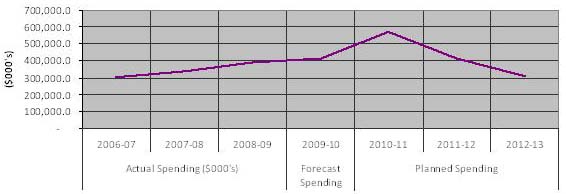 |
||||||
The increase of $155.1M (or 37%) between 2009-10 forecast spending and 2010-11 planned spending is mainly due to:
- additional funding for security costs related to the 2010 G8 Leaders' Summit ($96.7M);
- increased funding provided for the short-term sustainability of First Nations' Policing Agreements and the comprehensive review of the First Nations Policing Program (FNPP) ($8.3M);
- forecasted lapse in 2009-10 ($21.7M); and
- budget transfers to the RCMP for the FNPP made through Supplementary Estimates ($40.4M) in 2009-10.
Offset by:
- sunsetting of the Critical Policing Infrastructure program - Budget 2009 ($12.6M).
Planned spending from 2010-11 to 2011-12 will decrease by $156.8M (or 27%) primarily due to:
- sunsetting of security costs related to the 2010 G8 Summit ($128.7M);
- sunsetting of funding provided for short-term sustainability of First Nations' Policing Agreements and the comprehensive review of the FNPP ($17.1M);
- sunsetting of funding provided for the prevention of youth gangs under the National Crime Prevention Strategy ($7.4M); and
- sunsetting of funding to augment emergency management capacity ($8.5M).
Offset by:
- funding reallocated to 2011-12 to augment emergency management capacity ($4.2M).
Planned spending from 2011-12 to 2012-13 will decrease by $104.6M (or 25%) primarily due to:
- sunsetting of temporary funding provided to augment emergency management capacity ($4.3M); and
- temporary decrease of the Disaster Financial Assistance Arrangements (DFAA) program planned spending ($100.0M) while the funding mechanism is being reviewed.
The figure below displays the allocation of Public Safety Canada's planned spending by program activity for 2010-11.
($000's)
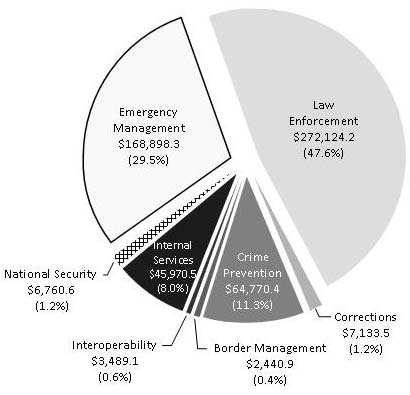
| Vote # or Statutory Item (S) | Truncated Vote or Statutory Wording | 2009-10 Main Estimates |
2010-11 Main Estimates |
|---|---|---|---|
| 1 | Operating Expenditures | 137,410 | 137,734 |
| 5 | Grants and contributions | 271,363 | 289,213 |
| (S) | Contributions to employee benefit plans | 13,235 | 13,704 |
| (S) | Minister of Public Safety – Salary and motor car allowance | 78 | 79 |
| TOTAL | 422,086 | 440,729 | |
